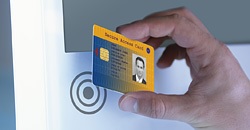NXP chip secures over 2 billion payment and ID cards

The firm's SmartMX technology ensures complete identity protection
NXP Semiconductors N.V. has shipped over two billion SmartMX secure microcontroller chips to the growing chip-enabled payment and government identity card markets.
The increasing adoption of contactless and dual interface payments cards in the financial sector and the increasing trend to issue electronic government documents means that security chips are being used more than ever to protect personal information and data.
With digital identity theft concerns at an all-time high, NXP's SmartMX technology ensures that personal information kept on banking cards, e-passports or national ID cards is always protected. Built on NXP's IntegralSecurity process, SmartMX products have over 100 advanced features for attack protection and have achieved Common Criteria Evaluation Assurance Level (CC EAL) 6+ certification, one of the world's most trusted and robust security profiles.
In the never ending race to offer advanced security protection, NXP continues to innovate and incorporate the latest technology to safeguard information. Future NXP SmartMX secure microcontrollers will feature PUF (Physically Unclonable Function) technology from Instrinsic-ID. PUF safeguards individual chips from data theft by using a unique 'fingerprint' to protect the encryption key, therefore making the device extremely hard to clone and reverse-engineer.
"The advancements made in digital government and contactless payment cards over the years have been remarkable. For NXP, reaching the 'two billion shipped' milestone for our SmartMX security chips clearly demonstrates the trust institutions and governments globally place in NXP to provide convenient and secure interactions," says Ulrich Huewels, vice president and general manager, secure card solutions, NXP Semiconductors.
"These organisations offer individuals peace of mind in our increasingly complex, open and connected world. It's imperative that we continue to develop best-in-class, innovative solutions that keep personal data safe," he adds.
Serving banks all over the world, from Shanghai to London and New York to Berlin, NXP's SmartMX secures transactions on over one third of the chip-based payment cards in circulation. Just over three billion chip cards are used today and in the coming years it will increase to over two billion magnetic stripe cards, currently the most widely used type of credit card, migrating to chip-based or contactless credit cards.
This aggressive migration is primarily driven by the implementation of the People's Bank of China (PBOC) IC card standard in China and the roll out of EMV-based banking cards in the United States. In addition to security, the convenience of tap and pay offered by contactless chip cards is driving the increasing adoption of dual-interface cards. Such cards can be used in both contactless applications as well as in contact terminals like ATMs. Contactless payment cards also provide improved efficiencies in the payment process, with transaction times of less than 300ms.
NXP's SmartMX products are also the core component in a wide variety of digital identity schemes and are deployed in close to 100 countries implementing government electronic ID programs. Used in many sovereign electronic documents such as ePassports, citizen cards, national ID cards, driving licenses, social security cards and, health cards,
SmartMX-based solutions protect citizens from identity theft and reduce fraud via the products' world class security features. Responding to the increasing pressure for effective online public administration processes and improved efficiencies, many governments consider electronic ID cards as the perfect solution, enabling citizens to securely and conveniently engage as needed. Electronic ID cards have become a prerequisite for an open and connected world where private and public businesses prosper.

































